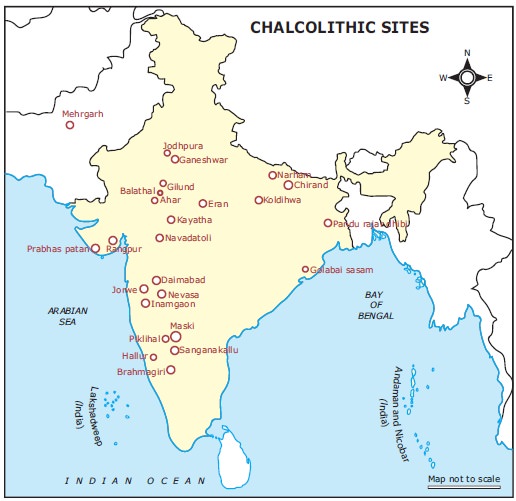From UPSC perspective, the following things are important :
Prelims level: Chalcolithic culture in India
Mains level: Not Much

The Chalcolithic cultures of Central India are adequately investigated and studied informed the Ministry of Culture in particular reference to the sites of Eran and Tewar.
Major sites in Central India
[1] Eran (Dist. Sagar, MP )
- Eran (ancient Airikina) is situated on the left bank of the Bina (ancient Venva) river and surrounded by it on three sides.
- The recent excavation has unearthed a variety of antiquities including a copper coin, an iron arrowhead, terracotta bead, stone beads along with copper coins, stone celt, beads of steatite and jasper, etc.
- The occurrence of few specimens of plain, thin grey ware is noteworthy.
- The use of iron was evidenced by few metallic objects at the site.
[2] Tewar (Dist. Jabalpur, MP)
- Tewar (Tripuri) village is located 12 km west of Jabalpur district on Jabalpur – Bhopal highway.
- This excavation did not reach the natural soil and revealed four folds of cultural sequences i.e. Kushana, Shunga, Satvahana, and Kalachuri.
- Antiquarian remains in this excavation include viz remains of sculptures, hopscotch, terracotta balls, Iron nails, copper coins, terracotta beads, implements of Iron and terracotta figurine, ceramics red ware etc.
- It also revealed structural remains consist of brick wall and structure of sandstone columns.
Back2Basics: Chalcolithic Culture in India
- A completely different kind of culture known as Chalcolithic Culture was developed in central India and Deccan region by the end of the Neolithic period.
- It is characterized by the use of both stone and bronze implements.
Major Chalcolithic complexes in India
- Ahar culture c. 2,800-1,500 B.C.
- Kayatha culture c. 2,450-700 B.C.
- Malwa culture c. 1,900-1,400 B.C.
- Savalda culture c. 2,300-2,000 B.C.
- Jorwe culture c. 1,500 -900 B.C.
- Prabhas culture c. 2,000-1,400 B.C.
- Rangpur culture c. 1,700-1,400 B.C.
Important features
- The people of Chalcolithic culture had used unique painted earthenware usually black-on-red.
- The use of copper and bronze tools also evidenced on a limited scale.
- The economy was largely based on subsistence agriculture, stock-raising, hunting, and fishing.
- They, however, never reached the level of urbanization in spite they were using metal.
- They were contemporary of the Harappan culture, but some other were of later Harappan age.
Their locations
- The centers of Chalcolithic cultures flourished in semi-arid regions of Rajasthan, Madhya Pradesh, Gujarat, and Maharashtra.
- The settlements of Kayatha culture were mostly located on the Chambal River and its tributaries.
- The settlements of Malwa culture are mostly located on the Narmada and its tributaries.
- The three best known settlements of Malwa culture are at Navdatoli, Eran, and Nagada.
- Navdatoli was one of the largest Chalcolithic settlements in the country spread in almost 10 hectares.
- The settlements of Rangpur culture are located mostly on Ghelo and Kalubhar rivers in Gujarat.
- More than 200 settlements of Jorwe culture are known. Greater numbers of these settlements are found in Maharashtra.
- The best known settlements of Jorwe culture are Prakash, Daimabad, and Inamgaon. Daimabad was the largest one that measured almost 20 hectares.
Development of Agriculture
- They cultivated both Kharif and Rabi crops in rotation and also raised cattle with it.
- They cultivated wheat and barley in Malwa region. Rice was cultivated in Inamgaon and Ahar.
- They also cultivated jowar, bajra, kulth, ragi, green peas, lentil, and green and black grams.
- Largely, the Chalcolithic cultures flourished in the black cotton soil zone.
Trade and Commerce
- The Chalcolithic communities traded and exchanged materials with other contemporary communities.
- A large settlement serves as the major centers of trade and exchange.
- Some of them were Ahar, Gilund, Nagada, Navdatoli, Eran, Prabhas, Rangpur, Prakash, Daimabad, and Inamgaon.
- The Ahar people settled close to the copper source and were used to supply copper tools and objects to other contemporary communities in Malwa and Gujarat.
- Identical marks embedded on most of the copper axes found in Malwa, Jorwe, and Prabhas cultures that might indicate that it may be the trademarks of the smiths who made them.
- It is found that Conch shell for bangles was traded from the Saurashtra coast to various other parts of the Chalcolithic regions.
- Gold and ivory come to Jorwe people from Tekkalkotta in Karnataka and semiprecious stones may have been traded to various parts from Rajpipla in Gujarat.
- Wheeled bullock carts were used for long distance trade, besides the river transport. The drawings of wheeled bullock carts have been found on pots.
Try this PYQ from CSP 2019. It is dicey, but you cannot escape such questions.
Q. Which one of the following is not a Harappan site?
(a) Chanhudaro
(b) Kot Diji
(c) Sohgaura
(d) Desalpur
Post your answers here.
UPSC 2022 countdown has begun! Get your personal guidance plan now! (Click here)
Get an IAS/IPS ranker as your 1: 1 personal mentor for UPSC 2024

c
C
c
c
C
C